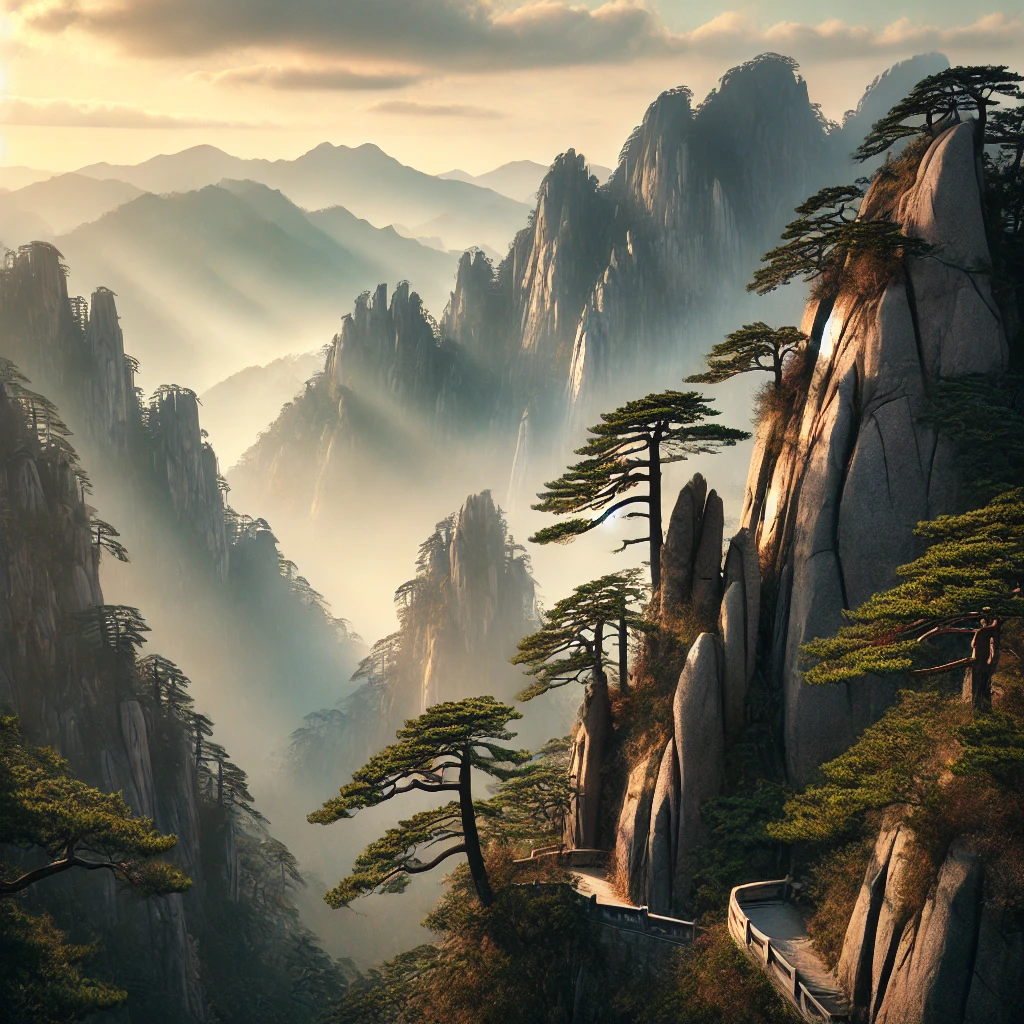Table of Contents
Introduction to China’s Natural Wonders
China, a vast country with a rich cultural heritage, is equally renowned for its diverse and breathtaking natural landscapes. From the sweeping mountains and expansive plateaus to lush forests and crystal-clear rivers, the natural beauty of China is a treasure trove that captivates nature lovers. The country’s geographical diversity results from its varied climate zones, ranging from tropical forests in the south to frigid tundra in the north, encompassing a broad spectrum of ecosystems. This vast array of environments supports a wealth of unique flora and fauna, making it an appealing destination for ecotourism.
Among the most significant aspects of China’s natural wonders is the presence of several national parks and protected areas that strive to conserve the country’s biodiversity. These regions not only preserve rare species but also offer visitors a chance to immerse themselves in China’s stunning scenery. From the majestic peaks of the Himalayas in Tibet to the picturesque karst formations in Guilin, each landscape tells a story of the earth’s evolution and cultural significance. Wildlife enthusiasts and hikers alike can find an endless array of marked trails and viewpoints that allow them to appreciate these pristine areas.

As we delve deeper into this blog post, readers can expect to discover ten remarkable locations that showcase the natural splendor of China. Each entry will highlight specific characteristics of the destination, including unique ecosystems, geological features, and the varied outdoor activities available. Be prepared to explore not only the famous destinations but also hidden gems that might be lesser-known yet equally enchanting for any nature enthusiast. This exploration will serve as a gateway to understand why China is one of the premier countries for appreciating nature’s exquisite artistry.
Zhangjiajie National Forest Park
Zhangjiajie National Forest Park, located in China’s Hunan Province, is renowned for its unique geological formations and breathtaking landscapes. The park is characterized by its towering sandstone pillars, which rise dramatically from the earth, creating an otherworldly atmosphere. These striking columns, some reaching heights of over 800 meters, have been recognized as an inspiration for the floating mountains depicted in the acclaimed film ‘Avatar.’ Visitors often express awe at the resemblance, which has prompted many to refer to the area as a real-life Pandora.
Within this magnificent park, diverse ecosystems flourish, including lush subtropical forests that are home to various plant and animal species. The rich biodiversity found in Zhangjiajie serves as a vital ecological area, supporting numerous rare and endemic species. Nature enthusiasts will appreciate the opportunity to explore the intertwining trails that lead to scenic viewpoints, showcasing the park’s stunning vistas. The Golden Whip Stream and the breathtaking Tianzi Mountain are among the highlights that offer various perspectives, making them popular hiking routes.

For those planning to visit Zhangjiajie National Forest Park, several practical tips can enhance the experience. It is advisable to allocate sufficient time to explore the park, as its vast area presents numerous opportunities for hiking, photography, and wildlife observation. Various viewing platforms, such as the famous Tianmen Mountain and the Avatar Hallelujah Mountain, provide excellent spots to appreciate the scenic beauty. Additionally, considering the park’s fluctuating weather patterns, it is best to wear comfortable footwear and prepare for sudden changes in temperature. With careful planning, visitors can fully immerse themselves in the extraordinary natural wonder that is Zhangjiajie National Forest Park.
Jiuzhaigou Valley National Park
Jiuzhaigou Valley National Park, located in Sichuan Province, is renowned for its breathtaking landscapes characterized by turquoise lakes, cascading waterfalls, and vibrant mineral-rich pools. Designated as a UNESCO World Heritage site, the park boasts an impressive array of biodiversity. Within its 72,000 hectares, one can find rare and endangered species like the giant panda and Sichuan golden snub-nosed monkey, making it a crucial area for wildlife conservation efforts.
The unique geological features of Jiuzhaigou are the result of a complex interplay between tectonic activity and glacial erosion. The park’s lakes, such as the iconic Five Flower Lake, are not only visually stunning but also play a significant ecological role by supporting various aquatic species. The rich variety of flora and fauna is complemented by the cultural significance of the area to the Tibetan people, who consider these lands sacred. Their historical narratives and presence add a profound depth to the experience of visiting Jiuzhaigou.

To fully appreciate the natural beauty of the park, it is advisable to visit during the autumn months when the foliage transforms into a palette of warm colors, enhancing the already vibrant scenery. Spring is another excellent option, as the melting snow reveals the stunning glacial lakes. Navigating the park can be accomplished via well-maintained trails, with designated pathways that provide access to the best viewpoints. The park operates shuttles that allow visitors to reach key sites like the Nuorilang Waterfall efficiently. To capture the most picturesque views, one should consider arriving early in the day or late afternoon when the light casts a magical glow over the landscape. Each season in Jiuzhaigou unveils a different facet of its beauty, making it a must-visit destination for nature enthusiasts.
Huangshan (Yellow Mountain)
Huangshan, also known as Yellow Mountain, is a renowned mountain range located in southern Anhui province, China. Recognized for its iconic granite peaks, Huangshan attracts nature lovers from around the globe seeking majestic landscapes and diverse flora. The peaks are often shrouded in clouds, creating a mystical atmosphere that has inspired poets and painters for centuries. This breathtaking backdrop has earned Huangshan the status of a UNESCO World Heritage Site, cementing its importance in both cultural and natural heritage.
Among its notable features, Huangshan is widely celebrated for its ancient pine trees, many of which have stood for hundreds of years. These resilient trees cling to the rocky cliffs, showcasing nature’s adaptability while enriching the mountainous scenery. Additionally, the region is home to natural hot springs, offering a unique way for visitors to unwind amidst stunning surroundings, and making it a popular destination for relaxation and rejuvenation.

The hiking trails that traverse Huangshan cater to various skill levels, making it accessible for both experienced trekkers and casual walkers. The well-maintained paths lead to different vantage points, each unveiling spectacular views of the granite formations, valleys, and distant mountains. Hiking at Huangshan provides an unparalleled opportunity to experience its unique climate, characterized by significant temperature variations and sudden shifts that can result in breath-taking fog-shrouded vistas.
Moreover, the sunrises and sunsets observed from Huangshan are extraordinary. The interplay of light and shadow across the rugged terrain creates a visual feast that draws photographers and nature lovers alike. As dawn breaks, the first rays of sunlight illuminate the peaks, transforming the landscape into a living painting. These experiences offer an unmatched connection to the natural world, reinforcing Huangshan’s status as a top destination for nature enthusiasts exploring the beauty of China.
Guilin and the Li River
Guilin, located in southern China, is renowned for its extraordinary karst landscape, characterized by dramatic limestone peaks that rise abruptly from the earth. This region is a breathtaking sight, offering nature lovers a plethora of awe-inspiring views and experiences. The Li River, which meanders through this picturesque area, enhances the beauty of Guilin, creating a scenic route that has become a favorite among travelers.
One of the best ways to appreciate the stunning scenery is through a leisurely boat ride along the Li River. The journey typically starts from Guilin and stretches to Yangshuo, covering approximately 83 kilometers of picturesque landscapes adorned with lush greenery, rice paddies, and traditional villages. The dramatic peaks, such as Elephant Trunk Hill and Nine Horses Fresco Hill, provide ideal backdrops for memorable photographs. Capturing these natural wonders during the golden hours of sunrise or sunset can result in breathtaking images, making it a delight for photography enthusiasts.

For those who prefer to explore on land, cycling routes around Yangshuo offer an excellent opportunity to immerse oneself in the tranquil countryside. Riders can pedal through charming villages and verdant fields, creating a unique connection with the local culture and landscape. Ensure you take breaks to savor local delicacies and engage with the hospitable residents. Popular cycling trails include the route to Moon Hill, which features an iconic natural arch shaped like a crescent moon.
Overall, the experience of visiting Guilin and the Li River is truly enchanting. By engaging in a boat ride and renting a bicycle, tourists can not only witness the stunning karst formations but can also appreciate the natural beauty and cultural richness of this exceptional region. The harmonious blend of nature and culture makes this destination a must-visit for any nature lover.
The Tibetan Plateau
The Tibetan Plateau, often referred to as the “Roof of the World,” is an extensive, elevated region in Central Asia, characterized by its vast and rugged terrain. It encompasses an area of approximately 2.5 million square kilometers, making it the highest and largest plateau on Earth. This unique geographical feature is not only a natural wonder but also of immense cultural and ecological significance. The plateau serves as a crucial watershed for many of Asia’s major rivers, including the Yangtze, Yellow, and Indus, thereby sustaining a diverse range of ecosystems.

The Tibetan Plateau is home to a variety of wildlife, some of which are endemic to this high-altitude environment. Among the notable species are the Tibetan antelope, known for its agile movements across the rugged landscape, and the elusive snow leopard, a solitary predator adapted to the cold, mountainous terrain. These animals, along with others like the Tibetan wild donkey and various bird species, contribute to the region’s rich biodiversity, drawing nature lovers and wildlife enthusiasts alike.
For trekking enthusiasts, the Tibetan Plateau offers unparalleled experiences, with its breathtaking views and challenging trails, particularly in areas such as Mount Everest and the Karakoram Range. These treks allow visitors to immerse themselves in the stunning scenery, including surreal landscapes, glacial lakes, and vast grasslands dotted with yaks grazing under expansive skies. When planning a visit, it is essential to consider the high-altitude conditions prevalent in the region. Proper acclimatization is crucial, along with a well-prepared travel itinerary. Additionally, visitors should be aware of the local customs and be respectful of the rich cultural heritage, as this area is home to various Tibetan communities.
Yunnan’s Stone Forest
The Stone Forest, located in Yunnan province, is a breathtaking natural wonder and a UNESCO World Heritage site that captivates nature enthusiasts with its surreal limestone formations. This extraordinary karst landscape spans approximately 400 square kilometers and features sharp, towering limestone pillars that rise dramatically from the ground, resembling a petrified forest. The unique topography has been shaped over millions of years through erosion, creating a mesmerizing environment that presents numerous opportunities for exploration and discovery.
Legend has it that the Stone Forest was once a beautiful girl named Ahu, who was turned to stone due to her heartbreak. This rich cultural narrative adds an enchanting dimension to the beauty of this geological marvel. As visitors wander through the twisting paths and towering formations, they can appreciate not just the stunning visuals but also the local folklore that enriches the experience.

For nature lovers, Yunnan’s Stone Forest offers a range of hiking trails suitable for various skill levels. The most popular paths provide breathtaking views of the stone formations, while more challenging routes meander through hidden sections of the forest, showcasing the diverse flora and fauna that inhabit the area. Guided tours are available to deepen one’s understanding of the geological and cultural significance of the site, often featuring insight into the traditions of the local Yi people.
The best times to visit the Stone Forest are during the spring and autumn months when the weather is mild and favorable for outdoor activities. These seasons allow visitors to fully immerse themselves in the natural beauty, explore the intricate rock formations, and connect with the local culture. In summary, Yunnan’s Stone Forest is an unforgettable destination that combines stunning natural landscapes with rich cultural experiences, making it a must-visit for nature lovers in China.
Zhangye Danxia National Geological Park
Zhangye Danxia National Geological Park, located in the Gansu province of China, is renowned for its extraordinary and colorful rock formations. Often referred to as the “Rainbow Mountains,” the park features a landscape adorned with vibrant stripes of red, yellow, green, and other colors that appear as if painted by an artist’s brush. This stunning display is the result of millions of years of geological processes, including the sedimentation of mineral-rich sands, erosion, and tectonic activity. As a result, the intricate layers of the earth have emerged, showcasing geological phenomena that are both rare and captivating.
The geological features in Zhangye Danxia offer an ideal subject for photography, attracting both amateur and professional photographers. When planning a visit, consider the timing of your trip, as the best time to photograph these natural wonders is during sunrise or sunset. The soft lighting enhances the colors of the hills and creates long shadows that add depth to images. Additionally, the use of a polarizing filter can help to accentuate the vibrancy of the rock formations, making them pop in photographs.

Accessing Zhangye Danxia National Geological Park is relatively straightforward. The closest major city is Zhangye, from which visitors can reach the park via a short drive or by taking a guided tour. It is advisable to spend at least a full day exploring the park to appreciate its expansive beauty and discover various viewpoints. Facilities within the park, including walking paths and viewing platforms, are designed to ensure that visitors can enjoy the scenery while maintaining a respectful distance from the natural formations.
For nature lovers and photography enthusiasts alike, a visit to Zhangye Danxia National Geological Park offers a unique opportunity to witness one of China’s most colorful landscapes, making it a must-visit destination on a journey through this diverse country.
Conclusion: Embrace Nature in China
China is a land of striking contrasts and breathtaking landscapes, making it an idyllic destination for nature lovers. From the towering peaks of the Himalayas to the serene beauty of its many national parks, the natural wonders of China invite exploration and appreciation. The remarkable biodiversity found in each region showcases not only the awe-inspiring beauty of the environment but also the crucial need for its preservation. Key locations such as Zhangjiajie National Forest Park, Jiuzhaigou Valley, and the majestic Yangtze River offer unique experiences that highlight China’s diverse ecosystems and geological formations.
These destinations, filled with lush forests, pristine lakes, and vibrant wildlife, capture the essence of the natural world. Each site serves as a reminder of the importance of conservation efforts. As we navigate environmental challenges globally, it becomes increasingly vital to protect and nurture these natural treasures. Visiting these incredible sites fosters a deeper understanding of nature’s complexity, urging individuals to recognize their role in safeguarding our planet’s ecosystems.
For those seeking adventure and connection with nature, China provides an abundance of opportunities. The exploration of its national parks, mountain ranges, and rivers allows travelers to experience the harmony between humanity and the environment. Engaging with these natural wonders not only enhances personal enrichment but also promotes a collective responsibility toward environmental stewardship.

In conclusion, as nature enthusiasts consider their next travel destination, the alluring landscapes of China should be at the forefront of their minds. The vast array of experiences waiting to be discovered—from tranquil hikes to exhilarating river rafting—calls upon adventurers to immerse themselves in the beauty of the great outdoors, ensuring that they leave with cherished memories and a renewed commitment to preserving our natural world.





